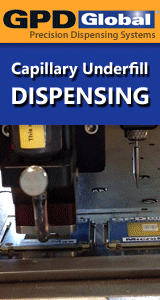Printed Circuit Board Assembly & PCB Design Forum
SMT electronics assembly manufacturing forum.
- SMTnet
- »
- Electronics Forum
- »
- Cracks on ceramic capacitors.
Cracks on ceramic capacitors.
![]() Hi
We are experiencing serious problem with ceramic capa...
- Jun 20, 2003
by
Cristiano
Hi
We are experiencing serious problem with ceramic capa...
- Jun 20, 2003
by
Cristiano
![]()
![]()
![]() Why don't you give us the full process along with your delt...
- Jun 20, 2003
by
RDR
Why don't you give us the full process along with your delt...
- Jun 20, 2003
by
RDR
![]()
![]()
![]() We had this problem with 0805 0.1 mF also. This problem was ...
- Jun 20, 2003
by
Sasha
We had this problem with 0805 0.1 mF also. This problem was ...
- Jun 20, 2003
by
Sasha
![]()
![]()
![]() Most of the time, Ceramic cracks are cracked due to mechanic...
- Jun 25, 2003
by
Most of the time, Ceramic cracks are cracked due to mechanic...
- Jun 25, 2003
by
![]()
![]() Suggest you ask vendor for a failure analysis. Ceramic chip...
- Jun 30, 2003
by
Suggest you ask vendor for a failure analysis. Ceramic chip...
- Jun 30, 2003
by
![]()
![]()
![]() suggest you check the preheat conditioning in the wavesolder...
- Jul 01, 2003
by
iman
suggest you check the preheat conditioning in the wavesolder...
- Jul 01, 2003
by
iman
![]()
![]()
![]() Are these caps on the bottom side or topside?
Bottomside ...
- Jul 01, 2003
by
Are these caps on the bottom side or topside?
Bottomside ...
- Jul 01, 2003
by
![]()
![]() Please send us more information about how the glue dots can ...
- Jul 01, 2003
by
Cristiano
Please send us more information about how the glue dots can ...
- Jul 01, 2003
by
Cristiano
![]()
![]()
![]() The vast majority of issues I have seen are from depaneling ...
- Jul 02, 2003
by
The vast majority of issues I have seen are from depaneling ...
- Jul 02, 2003
by
![]()
![]() I've seen numerous incidences of mirror image cracking under...
- Jul 04, 2003
by
I've seen numerous incidences of mirror image cracking under...
- Jul 04, 2003
by
![]()
![]() Hi,
In most of the cases we are not able to detect the sour...
- Jul 07, 2003
by
Vijay
Hi,
In most of the cases we are not able to detect the sour...
- Jul 07, 2003
by
Vijay
![]()
![]()
![]() Do you know what the maximum temperature rating is for the d...
- Jul 07, 2003
by
Do you know what the maximum temperature rating is for the d...
- Jul 07, 2003
by
- SMTnet
- »
- Electronics Forum
- »
- Cracks on ceramic capacitors.








